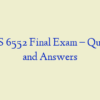Description
COUN-6311S-5/COUN-6311D-5-2021-Summer-QTR-Term-wks-1-thru-10
Quiz – Week 4
50 out of 50 points
- Dr. S.C. is implementing a brand-new friendship curriculum at school. Dr. S.C. would like for 75% of kindergarteners (225 out of 300) to be able to identify 4 behaviors of good friends verbally or in drawings by the end of the 1st semester of school. When creating the action plan, which of the following Mindsets & Behaviors would be the best choices for Dr. S.C. to address?
- All the following responses can be examples of how school counselors practice distributed leadership EXCEPT:
- Which of the following is not data collected by school counselors?
- When a school counselor has created a goal that students do not meet by the end date, best practices suggest ending the initiative and locating an alternative population or topic to address during the following school year.
- What piece of data is missing in the following program goal? Economically disadvantaged students who earned an F in English 10 on their fall progress reports will decrease the number of F’s earned by 15% from 50 F’s to 42 F’s.
- A horizontal school counselor leader may:
- An example of a properly formatted SMART goal is:
- “Chairing a committee on campus climate, serving as an advisor to a student group, and serving on a school wide student issues committee” are all examples of:
- Action plans are intended to remain consistent throughout each school year with little to no modifications or adjustment.
- Success in school counseling leadership includes, but is not limited to:
- Follow-up is only necessary for an action plan or initiative if the students do not meet the intended goal.
- In her self-advocacy video, Michele Lopez explained that the process of self-advocacy:
- When working with school administration, one way to advocate for performing appropriate school counseling duties in your comprehensive school counseling program is to refuse to perform any and all duties deemed by the American School Counseling Association (ASCA) National Model as an inappropriate activity.
- Closing-the-gap action plans identify:
- The ASCA National Model emphasizes that a program of effective leadership, collaboration, and advocacy will result in:
- While attending the state ASCA conference, Justice Star was introduced to an evidenced-based anger management program to use with 8th-grade boys. Justice has already identified students who would benefit from this small-group activity and planned out how many sessions she plans to conduct. When Justice gets back to school, how many students are not recommended to measure the effectiveness of these small-group efforts?
- Which element of the ASCA National Model includes the writing of the mission statement?
- Which component of the ASCA National Model best addresses the areas of advocacy, leadership, collaboration, and consultation?
- Which of the following reveals information about thoughts, feelings, behaviors, and attitudes such as attendance rates, suspensions and expulsions, staff relations, campus morale, embracing diversity, and campus safety?
- The Manage component of the ASCA National Model addresses the school counseling program’s:
- Which setting provides the best way to ensure that students in a targeted action plan are in the best position to learn the skills, attitude, or information shared by school counselors?
- Vision statements can include all the following components, except:
- What piece of data is missing in the following program goal? By May 5, 2022, students who had 15–20 absences during the first semester will decrease the number of absences by 10%.
- An example of a properly formatted SMART goal is:
- A person who speaks, writes, or acts to promote the well-being of students, parents/guardians, and the school counseling profession.



